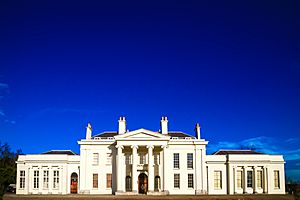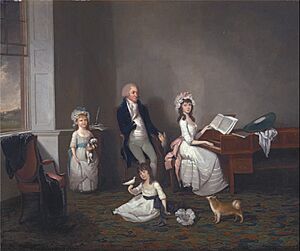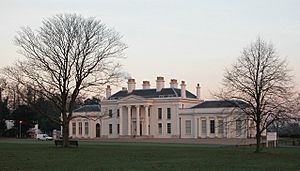Hylands House facts for kids
Hylands House is a beautiful old building in Chelmsford, Essex, England. It's a special type of house called a neo-classical villa. It sits inside a huge park called Hylands Park, which is about 232 hectares (or 574 acres) big. The local council, Chelmsford City Council, owns and takes care of Hylands House and Park.
Contents
History of Hylands House
The last private owner of Hylands House lived there until 1962. By 1966, the house was in very bad shape. That year, Chelmsford Borough Council bought the park. They wanted the people of Chelmsford to enjoy it. Hylands Park opened to the public just 10 days later.
The council decided to bring Hylands House back to its original beauty. It had been empty for 20 years. The first part of the restoration started in 1986. The final stage was finished in September 2005.
Past Owners of Hylands House
Sir John Comyns: 1730–1740
Around 1726, a respected lawyer named Sir John Comyns bought land in Writtle. He decided to build a new home there. This home would be suitable for someone important like him. Hylands House was finished in 1730. It was an elegant, two-story red brick building. It was built in the Queen Anne style architecture. The gardens around the house were designed in a formal, geometric way. There was a pleasure garden and a small kitchen garden.
The Comyns Family: 1740–1797
Sir John Comyns passed away in 1740. He did not have any children who survived him. So, he left the estate to his nephew, John Comyns. In 1759, John Comyns ordered a special monument. It was to honor his uncle and can be seen in Writtle Church. John then left Hylands to his son, John Richard Comyns, in 1760.
Cornelius Kortright: 1797–1814
In 1797, Cornelius Kortright bought Hylands House. He hired a famous landscape architect, Humphry Repton. Repton suggested adding new sections to the east and west. He also suggested a grand entrance with columns. The whole house was then covered in white stucco.
Kortright bought an extra 150 acres of land. This was to make space for Repton's plans. By 1814, many changes had been made to the estate. However, Kortright's family grew very large. They needed a bigger home. So, they moved to a different house nearby before Hylands was fully finished.
Pierre Cesar Labouchere: 1814–1839
Pierre Cesar Labouchere was a banker from the Netherlands. He bought Hylands Estate in 1814. He worked to finish Repton's design for the house and park. This is how the house got its balanced neo-classic look that you see today.
Labouchere created the beautiful Pleasure Gardens. With help from architect Williams Atkinson, he built the Georgian Stable Block. He also collected neo-classical sculptures. Some of these were by the Danish artist Bertel Thorvaldsen. Copies of these sculptures are now on display in the house.
John Attwood: 1839–1858
After Labouchere passed away, his son Henry Labouchere sold Hylands House. The new owner was Mr. John Attwood. He used to own an ironworks in Birmingham. Attwood was a very ambitious businessman. He wanted a property that showed his new important status. He also hoped to become a lord.
Attwood was a Member of Parliament for Harwich. He felt Hylands was not grand enough for him. So, he made the house much bigger and redecorated it completely. He bought over 3500 acres of land around Hylands. He also made the road from Writtle to Margaretting private. This road used to run through the estate.
Attwood later faced money problems. He had to sell the house and estate. He then moved to France.
Arthur Pryor: 1858–1904
Arthur Pryor was a partner in a brewery. He bought a smaller Hylands Estate in 1858. He did not change much in the house. He mainly redecorated some parts. Some of the fancy decorations in the Banqueting Room are thanks to him. Pryor's oldest son inherited the estate. However, he chose to rent it out instead of living there himself.
Sir Daniel Gooch: 1904–1920
Sir Daniel Gooch first rented Hylands House and land in 1904. He then bought it in 1907. He made the house more modern. He had electricity and telephones installed. The Gooch family often hosted parties. They had shooting parties and outdoor events. There was a big celebration for the coronation of King George V.
During World War I, Hylands House was used as a military hospital. Over 1,500 patients were treated there. Sir Daniel was also an explorer. He went with Sir Ernest Shackleton on his trip to the South Pole. However, Sir Daniel had to return home early because of severe frostbite.
Mr. John and Christine Hanbury: 1922–1962
In 1920, Hylands was sold to a group of local gentlemen. But just two years later, John Hanbury bought it. Like Arthur Pryor, John was the chairman of a brewing company. However, John Hanbury passed away suddenly in 1923. He died before he could even move into Hylands.
Christine Hanbury was later left alone. Her son, Charles John MacKenzie (Jock) Hanbury, was one of the first pilots to die in the Second World War. He died in a flying accident. Christine Hanbury made many changes to the grounds. She added a lawn tennis court and rhododendron borders. She replaced the wooden fence in front of the house with a stone wall called a ha-ha. She also created a private garden area. This area was dedicated to the memory of her husband and son.
During World War II, the estate was used as a German Prisoner of War Camp. The house itself was used by the SAS as their main office.
Mrs. Christine Hanbury passed away in 1962 at 89 years old. She left the house and estate to her trustees. For the last time in its history, Hylands was put up for sale. Chelmsford Borough Council bought the house and estate at an auction in 1966. They opened only the park to the public. The house was in very bad condition because of a fire. By 1971, the servants' living areas had been torn down. There was a vote to knock down the entire house. Luckily, this idea was defeated by a close vote of 15 to 9.
Restoring Hylands House
The house was getting worse and worse. But even in its poor state, Hylands House became a Grade II listed building in 1967. This meant it was a special building that needed to be protected. In 1985, the Borough Council started a fund to restore it. Later that year, English Heritage agreed to the council's plan. The plan was to bring the house back to its early 19th-century look. Before work began, Hylands House was re-graded to a Grade II* listed building. This made it even more important.
Restoration work began in 1986. It was led by Borough Architect Esmond Abraham. By 1996, the outside of the house was finished. The Entrance Hall was also restored to its grand Regency style. A group called The Friends of Hylands House was formed. They raised money to help furnish the house.
The final part of the house restoration was completed in September 2005. This was led by Susan Ireland, the Director of Parks and Heritage Services. She received a grant of £18,700 from the Heritage Lottery Fund. This money was part of a larger award for the whole estate. It helped finish the house. It also helped restore the Stable Block and the landscape designed by Humphry Repton.
Restoring Hylands Park
A lot of work began in 2004 to restore Hylands Park. The goal was to bring back its beautiful 18th-century design. This design was created by landscape architect Humphry Repton. The park restoration was finished in 2007. Susan Ireland also led this project. She got a grant of £3.4 million from the Heritage Lottery Fund. The Council also helped with funding.
Recent Events at Hylands
From 1996 until 2017, Hylands Park hosted the yearly V Festival. In 2018, it became the RiZE Festival for one year. In 2022, Creamfields took over the annual festival. It is now called Creamfields South Festival.
In the 2004 movie Chasing Liberty, Hylands House was used as a stand-in for the US White House. In 2005, Hylands Park was the location for the European Scout Jamboree. In 2007, Hylands welcomed scouts from over 160 countries. This was for the 21st World Scout Jamboree. It celebrated 100 years of scouting. The One World Garden was created to remember this special event. It is now part of the estate.
In 2019, the Netflix series The Crown Season 3 also used Hylands House. It was again used to look like the White House.
Today, the Stables section of the house is an Arts Quarter. It is a place for art and creative activities.




